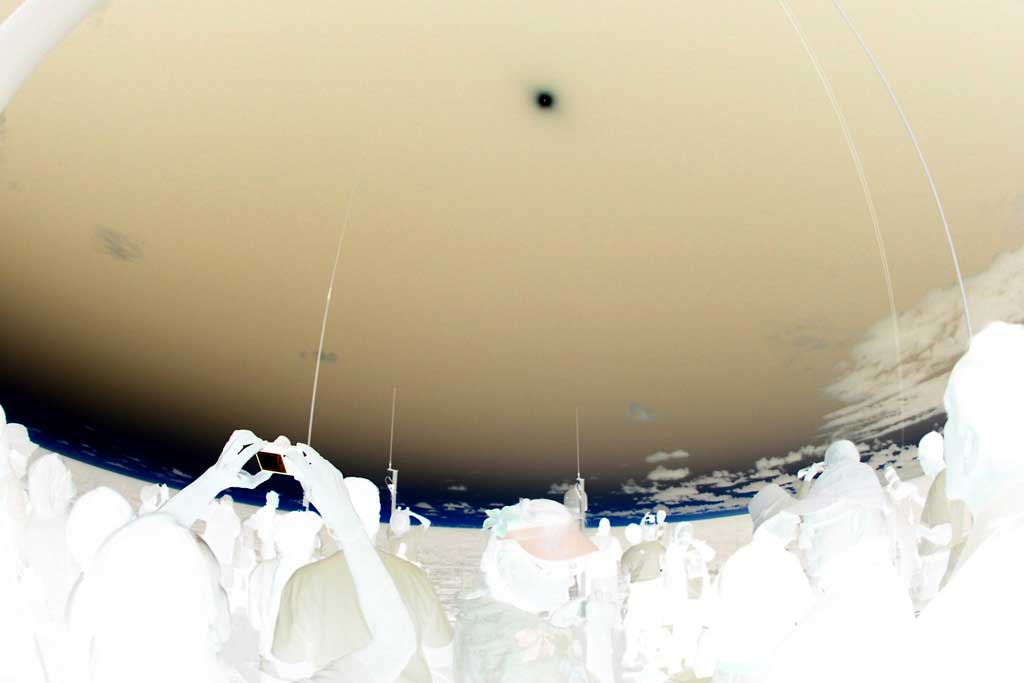On November 14, 2012, I watched without optical aid as the Moon covered the Sun. From the deck of Celebrity Cruise’s Millennium in the South Pacific, the other passengers and I enjoyed 3½ minutes of eclipse totality under a cloud-free sky. Perhaps the most inspiring sight occurred just before second contact, when the Moon’s edge was poised to cross in front of the Sun and began the total eclipse. Sunlight fringed the Moon’s leading edge, which lingered for an inordinate amount of time in what is known as the “diamond ring effect.” Then, the corona flared to prominence with diaphanous petals fully encircling the Moon’s silhouette. If I used averted vision, the coronal petals tapered into fine threads of silk that tickled the surrounding indigo sky.
One of the more subtle coronal details visible to the eye was its extremely pale sea-green color. I had seen this hue before, but not so noticeably. If I relaxed my gaze and looked slightly away from the Sun, but kept my attention on the corona, totality seemed awash in green light.
Zodiacal light?
Near the end of the eclipse, with perhaps only 30 seconds to go, I once again relaxed my gaze and noticed a mottling on the Moon’s dark face. While in this relaxed state, and by then being somewhat dark-adapted, my eye suddenly caught sight of a very dim strip of light that extended along the zodiac about 10°–15° — half the distance to Venus to the west and clean through Mercury to the east. Curiously, the dim glow seemed to trumpet open on either end.
The appearance of this band had none of the visual characteristics of the corona. In fact, it looked as if the eclipsed Sun with its bright, irregularly round corona was “tacked on” to this extremely faint band.
Given that the light strip followed the zodiac, I had to wonder if it was not, in fact, some rare coronal feature that extended into the zodiacal light — the milky band of dust (from comet dust and asteroid collisions) lying in the plane of the inner solar system out to about the orbit of Jupiter. I would love to hear from others who may have thoughts (or images) of this phenomenon.
Near the end of the eclipse, with perhaps only 30 seconds to go, I once again relaxed my gaze and noticed a mottling on the Moon’s dark face. While in this relaxed state, and by then being somewhat dark-adapted, my eye suddenly caught sight of a very dim strip of light that extended along the zodiac about 10°–15° — half the distance to Venus to the west and clean through Mercury to the east. Curiously, the dim glow seemed to trumpet open on either end.
The appearance of this band had none of the visual characteristics of the corona. In fact, it looked as if the eclipsed Sun with its bright, irregularly round corona was “tacked on” to this extremely faint band.
Given that the light strip followed the zodiac, I had to wonder if it was not, in fact, some rare coronal feature that extended into the zodiacal light — the milky band of dust (from comet dust and asteroid collisions) lying in the plane of the inner solar system out to about the orbit of Jupiter. I would love to hear from others who may have thoughts (or images) of this phenomenon.
Different strokes
While this feature was visible without a telescope or photographic setup, some observers surely caught it on camera. Equipment and technology have now evolved to the point where even inexpensive pocket cameras can capture images rivaling some professional ones. The shots provide users with not only the thrill of success but also stunning views they can share instantly over the Internet, satiating the thirst of followers. Over the years, I’ve watched people’s excitement at shooting totality overshadow the viewing of it. On the opposite side of the spectrum, we have those who choose to view the eclipse but generally keep what they see close to the chest — the eclipse being for them more of a personal and a spiritual experience than a purely scientific quest.
In the future, I anticipate the photographic experience will continue to go supernova over the Web. I also foresee totality continuing to implode into the souls of individual viewers. There always will be plenty of people in both camps. There is a third group of people, though: those who are interested in scientific, naked-eye viewing. I’m uncertain about the future of such visual observations during totality. Do you think there is any value remaining to observing (not merely watching) an eclipse? Email your thoughts to someara@interpac.net.
While this feature was visible without a telescope or photographic setup, some observers surely caught it on camera. Equipment and technology have now evolved to the point where even inexpensive pocket cameras can capture images rivaling some professional ones. The shots provide users with not only the thrill of success but also stunning views they can share instantly over the Internet, satiating the thirst of followers. Over the years, I’ve watched people’s excitement at shooting totality overshadow the viewing of it. On the opposite side of the spectrum, we have those who choose to view the eclipse but generally keep what they see close to the chest — the eclipse being for them more of a personal and a spiritual experience than a purely scientific quest.
In the future, I anticipate the photographic experience will continue to go supernova over the Web. I also foresee totality continuing to implode into the souls of individual viewers. There always will be plenty of people in both camps. There is a third group of people, though: those who are interested in scientific, naked-eye viewing. I’m uncertain about the future of such visual observations during totality. Do you think there is any value remaining to observing (not merely watching) an eclipse? Email your thoughts to someara@interpac.net.












